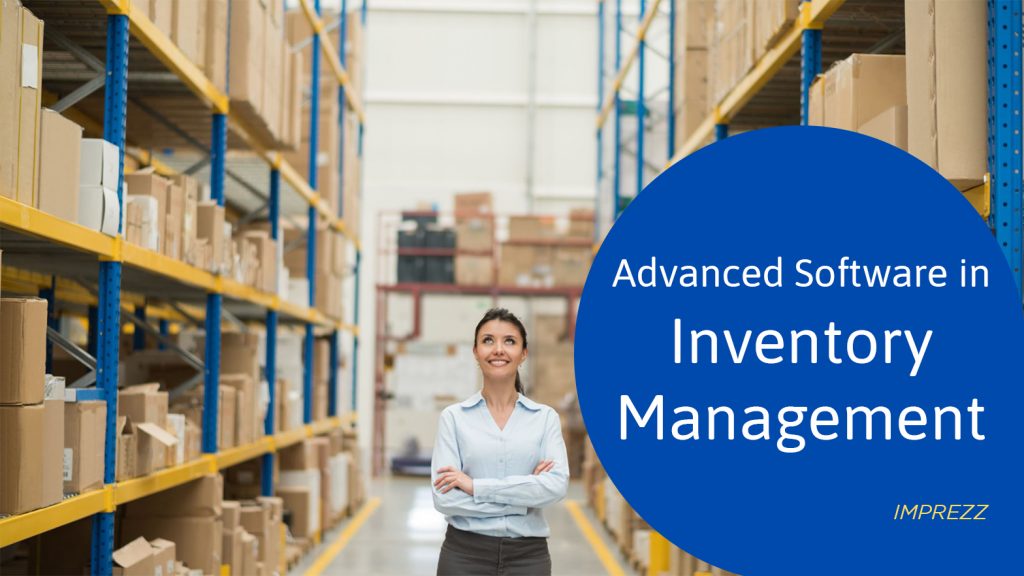
Inventory Management Software is the heart of a business, and its importance can never be undermined. Imprezz Inventory management uses advanced inventory management features to ensure seamless functioning of the supply chain through effective communication and clarity in analysing each and every step.
WHAT IS AN INVENTORY MANAGEMENT SYSTEM?
An Inventory Management system helps a firm keep a check on incoming and outgoing stocks to best meet the fluctuating customer demands, along with avoiding common problems like under-stocking and over-stocking. The system takes care of every essential business function, including warehouse management, accounting, production and also the sales team. To know more, read: INVENTORY MANAGEMENT: A COMPREHENSIVE GUIDE
WHAT TO LOOK FOR IN AN INVENTORY MANAGEMENT SOFTWARE?
The key specifications to look for in an Inventory Management system involve providing a method to store, manage, organize and analyse all the inventory data quickly and seamlessly. These requirements include:
- User Interface: An easy-to-use interface, which provides all the advanced features but not necessitating taking courses, support or the help of documentation.
- Automation: An inventory management system must facilitate automation, reducing time and effort in performing manual and repetitive tasks. These manual and repetitive tasks are best served by computers with nearly perfect accuracy in a fraction of time, hence providing additional time to devote to analytical studies for growing the business.
- Security: Another vital necessity of advanced Inventory Management software is to provide a secure and reliable database where the data can be stored without any hassle and can be retrieved whenever needed. The accurate and real-time data provision is only possible through advanced software like the cloud computing software of Imprezz.
- Performance: The system must provide fast and efficient inventory management and control with no significant bugs or any other anomaly in the performance. A smooth experience is what’s needed when dealing with loads of data, and it all boils down to the performance efficiency of the inventory management software.
- Scalability: While a small business is in the budding state, its primary requirement is an inventory management system that is scalable. Many new employees would join in various positions during its growth, and the data is to be organized perfectly for clarity. A system that has features to add software modules with minimal configuration is the fundamental requirement and it is possible in coherence with a simple user interface in software like that of Imprezz.
WHAT ARE SOME IMPORTANT FEATURES?
Advanced systems have a plethora of features for various different categories of Inventory Management. These include features for managing, controlling, planning, organizing, stocking and methods of selling. Let’s analyse and see what they are:
- Inventory Control Features: Inventory control is the handling and managing of the stocks already in the warehouse as raw materials and is a very crucial step in Inventory Management. It is so crucial because a large part of the total cost goes into buying the inventory, and if a mistake happens in Inventory Control, it directly impacts the working capital, and the firm incurs a heavy loss. The various features to be expected from Inventory Management systems like Imprezz are tools to analyse and categorize the inventory by types, profit margins and serial numbers. The software should be able to audit, filter, and analyse all the inventory data in real-time.
- Inventory Management Features: Inventory management takes care of the systematic and smooth functioning of the entire supply chain. It governs not only Inventory Control but also the processes before the arrival of Inventory in the warehouse and the processes after leaving the warehouse as finished goods, including distribution and sales quotation generating analysis. For large businesses, various features are necessary like multi-location warehouse management, Enterprise Resource Planning (ERP) software integration, and others. For small and medium businesses, Imprezz offers tools for real-time tracking of inventory and data collected directly in the cloud. Paperless invoicing, purchase order and Quotation generation are a few of the most important features which are necessary for any good inventory management system.
- Inventory Tracking Features: In order to practice inventory control, it becomes essential to have a real-time tracking system of each and every inventory arriving and leaving the warehouse. The status of products and materials are tracked using features like Perpetual Inventory tracking to help automate manual tasks like cycle counting and save time. These also help in reducing data errors and other mistakes because machines are more efficient and faster in performing manual tasks than humans.
- Inventory Optimization: Take the inventory management process to the next level by following certain Inventory Management optimization techniques. Using sophisticated software like Imprezz helps you gain an edge by providing the most advanced features to help you in this digital age of businesses. What matters now is not who are using digital means, but how they are using them. Tools that provide automated reports, help analyze the inventory supply-demand ratio, and a view of the fluctuating customer demands for reorder point using analytical tools are a must to beat the competition in the market. This clarity helps optimize inventory and be a better version of your business.
- Inventory Alert Features: The alerting features help in reducing wastage, optimize inventory costing, and improving customer satisfaction through quick response. The various features include payment reminders, automated emails, etc. Visit Imprezz to know about all the features. Inventory alerts help in operational control, logistics and effective forecasting for enhanced Warehouse Management.
WHAT ARE SOME ADVANCED FEATURES TO CONSIDER?
Advanced Inventory Management systems like Imprezz have a few advanced features making them unique from others. These features provide an edge to your business by taking it into another dimension. What are some of these modern features? Let’s find out.
- Cloud Infrastructure: For a SaaS system, cloud infrastructure is a must. This advanced feature helps you track data in real-time by providing all the data entered directly in the cloud. The primary advantage is that the data is accessible from anywhere wherever you go. The data kept in the cloud has a network of kernels to provide ultimate security to the data, and hence the data is accessible without the threat of getting lost. Automatic backups, security and real-time collaboration of every level of the supply chain are the perks of having a cloud infrastructure.
- Internet of Things (IoT): IOT integrations are used by medium and large businesses to keep real-time track of each and every inventory wherever they go. This technology also helps against thefts or data breaches by following digital labelling, GPS Tracking and other Inventory Control methods. IoT helps track all the packages leaving a warehouse in real-time integrating it with the cloud platforms so that the data is transferred instantaneously to the central database where it is kept secured and ready at bay.
- Mobile Systems: A budding feature, an essential in supply chain management is the use of mobile systems, which help in collaboration through wireless devices with the help of central databases and back-office systems to speed up the processes of the supply chain. Using mobile devices help in quickly responding to inventory notifications and real-time tracking of data.
- Machine Learning and AI: Chatbots are becoming an integral part of any website, be it an e-commerce website or a clothing apparel distributor. They use advanced systems like Machine Learning algorithms and other web-based tools to analyse the stock levels, the inventory levels stocking, make actionable recommendations based on previous historic forecasting or demand forecasting for safety stock. Sales data trends can also be sorted by deploying machine learning software and are critical in organizing customer demands. These lead to a decrease in common problems of over-stocking or under-stocking.
IMPREZZ INVENTORY MANAGEMENT SOFTWARE
Imprezz Inventory management software integrates all the techniques of inventory management for the seamless functioning of the supply chain. It takes care of all aspects of the inventory processes, right from categorizing customers on the dashboard, all the way upto analysing and filtering data to suit a client’s need. This helps build healthy customer relations and avoid discrepancies because of the clarity of the supply chain provided by Imprezz. What’s more important is the centralized database created due to the integration of cloud platform providing real-time tracking of data. This helps keep your data at your fingertips with the most secure encryption so that the data is never lost or face any security breach.
Having advanced features like constant support from experts through 24 hours chat, Imprezz helps you manage your inventory in the best way possible. Having an edge in this digital era of business requires the perfect integration of advanced software with the desired skills. Have an edge over your competitors by signing up for a free trial of 14 days.

The central board of Indirect taxes and custom (CBIC) issued a notification and made it mandatory for businesses with turnover over 50 Cr in any fiscal year from FY 2017-18 onwards to issue e-invoice for all B2B transactions from April 1, 2021. It came in as the third level of implementation. Earlier, the GST e-invoicing was made a mandate for businesses with turnover over 500 Cr from October 1, 2020, followed by companies with a turnover of over 100 Cr from January 1, 2021.
The businesses will have to generate e-invoices on their internal systems (accounting/billing software) and then report them online on the Invoice Registration Portal (IRP).
The Invoice Registration Portal (IRP) will validate the information provided in the e-invoice and return digitally signed e-invoices with a unique Invoice Reference Number (IRN) and a QR code to the taxpayer.
How will e-invoicing impact business operations?
First and foremost, businesses will have to integrate their systems with the invoice registration portal of the government for an undisrupted flow and generation of Invoice Reference Number for all B2B transactions. Also, businesses may have to make changes in their software to comply with the e-invoicing schema.
There is a need to add more information to the invoices hence, companies will have to adjust and change the billing layout to accommodate and print QR codes. Additionally, businesses will also have to invest capital in providing necessary training to the personnel involved in GST compliance.
These may be some hindrances, but businesses will save a lot of time and effort as far as GST compliances are concerned. The automated system will eliminate any scope of human error and ensure the formulation of accurate invoices.
Some other ways in which e-invoicing will impact business operations are:-
- Businesses will now have to identify the transactions to which e-invoicing will apply and separate them for compliance.
- Businesses will have to make changes in GST returns process so that B2B transactions can be auto-populated, while B2C transactions will have to be added manually.
- Another significant impact that businesses will encounter is the continuous generation and capturing of Invoice Reference Number (IRN). They will have to integrate with GSP (GST Suvidha Provider) for smooth billing and generation of e-invoice.
- Businesses will have to maintain and update masters of vendor and customers to cater to additional information now required in invoices like payee details, bank details, PIN codes, etc.
Standard modes for generation of IRN
- Web-based: the taxpayers can generate IRN by entering invoice details through the website of IRP.
- SMS-based: The taxpayer will have to enter invoicing details in a specified format and send it to the IRP through SMS.
- Mobile application-based: GSTIN has also made mobile apps for taxpayers to comply with e-invoicing compliances.
- API-based: The accounting system can interact with IRP to generate IRN. IRN can be generated one at a time and also in bulk.
- GSP-based: the taxpayers can use GST Suvidha Provider (GSP) services for the generation of IRN.
READ OTHER BLOGS BY IMPREZZ
Basics: Accounts and Records under GST
GST Rules for Start-ups in India
Which GST compliant Software to use for Invoicing?

Finance Minister Nirmala Sitharaman announced that the next Goods and Service Tax Council meeting will be held on May 28, via Video Conferencing due to the current pandemic situation. The announcement was made by the finance minister in a Twitter post on Saturday. “Smt Nirmala Sitharaman will chair the 43rd GST council meeting via video conferencing at 11 AM in New Delhi on 28th May 2021,” the Twitter post revealed.
There is a gap of six months since the last meeting, following the rising demands of the state finance ministers, even from West Bengal and Punjab. This week, Bengal finance minister Amit Mitra had written to finance minister Nirmala Sitharaman stating the urgency of conducting the GST Council meeting. The meeting was called to discuss the demanding issue of increasing the compensation of Rs. 1.56 Lakh crore issued for states in FY22.
As per the projection of the Government of India, without taking consideration of the Covid-19 pandemic, the shortfall was expected to be around Rs 1,56,164 crore in 2021-22. Now due to the sudden pandemic of Covid-19, the compensation will be much higher than it was earlier projected.
The centre had also provided a constant source of loans to the states amounting to Rs. 1.1 Lakh crores to make up for the GST Compensation shortfall of FY21. In the month of March, the finance ministry stated that a compensation of Rs. 63,000 crores were pending to states and Union Territories in accordance with the GST Compensation shortfall in FY21.
The Punjab finance minister had some other important matters to be discussed in the GST Council regarding the pandemic situation. It would be on whether GST would be exempted from the pandemic commodities and essentials such as hand sanitizers, gloves, face masks, PPE Kits, ventilators, oximeters and temperature check instruments. The issue of cut interest rates is also a topic of discussion.
Apart from the possible inclusion of petroleum products under GST to ease the tax burden, other state matters such as 5% GST on covid vaccines are to be discussed in the virtual meet. This meeting has been made possible because the elections are out of the way, and the new government is taking charge.
Check Out:
- Role of inventory management in purchase order
- GST Rules for Start-ups in India
- Transfer of Business and GST Implications

The beginning of a supply chain starts with a purchase order. Imprezz helps in automation and speeding up Purchase Order. The efficiency of the purchasing team plays a vital role in the Inventory Management for the entire supply chain. The mistakes causing the firm to incur drastic losses can be significantly reduced by optimising the purchase order and maintaining clarity throughout the process. Let us understand each point one-by-one.
WHAT IS A SALES ORDER?
A sales order is a commercial document, or a legally binding contract generated by the seller and issued to the customer, confirming the sale of goods, the necessary specifications and other criteria involved in the transaction. This generally includes the price, description, quantity, details of the buyer like shipping and billing address, mode of payment, and terms and conditions.
A sales order is an internal document containing information on the logistics generated by the vendor and kept on record for the proper tracking of charge till the loop of the supply chain process is completed. They are most commonly used by vendors, suppliers, retailers, manufacturers, and wholesale providers.
The following steps are generally followed in a business:
- The supplier sends an official quote to the buyer after the Request For Quote (RFQ) has been sent
- If the quote is accepted, the buyer sends a purchase order to the seller
- The seller drafts a sales order following the terms in the purchase order
- The customer verifies the details in the sales order, including the exact specifications, the price quoted, the shipping and billing address, mode of transaction, etc. Some businesses skip this step altogether
- After the consignment is shipped, an invoice is generated from the sales order
THE SUBTLE DIFFERENCE BETWEEN SALES ORDER AND PURCHASE ORDER
The only difference between sales order and purchase order lies in the fact that who issues the legally binded document and for whom.
- A Purchase Order is an official confirmation of a buyer to buy the inventory from the supplier. It is a buyer who creates this document, mentioning certain aspects of the transaction, such as specified quantity, mode of transaction, specified price, etc.
- Once the Purchase Order reaches the vendor, the vendor starts drafting the Sales Order according to the Purchase Order sent by the customer. This is created in adherence to the details specified in the Purchase Order.
PURCHASE ORDER VS INVOICE
After sending the details through the Purchase order, the vendor drafts the Sales Order using automated sales. After this document is completed, the Supplier sends an official invoice to the customer specifying the exact amount of money the customer owes the vendor in return for the exchange of goods and services agreed upon in the official documents of Sales and Purchase Orders.
It is easy to be confused between Sales Order and Invoice because both are generated by the Vendor and sent to the Buyer. The main point distinguishing both is the exact timing and their respective purposes.
- A purchase order specifies the details of the consignment, the price quantity, and other logistical stuff for purchase request confirming the sale of the inventory, prompting the vendor to start assembling and packaging the inventory for shipment.
- An invoice is an official document mentioning the payment details on when and how to pay for the goods and services for the amount agreed upon during the agreement. Read this blog: Latest Updates in GST Invoice Rules: COVID 19
WHAT IS THE CONNECTION BETWEEN PURCHASE ORDER AND INVENTORY MANAGEMENT?
The importance of purchase orders for Inventory Management and other Management systems cannot be overlooked. The importance is elucidated in the underlying points:
- Prevention from Under-stocking or Over-stocking: The purchasing process specifies the exact amount of Inventory being purchased and hence following the ordered quantity, a proper strategy can be devised using advanced software like Imprezz to use the analytics tool and prepare accordingly. This becomes the responsibility of the purchasing department to maintain the necessary flow in the supply chain.
- Application of Inventory Management Techniques: To specify the details of the inventory being bought, the proper application of Inventory management techniques like JIT and EOQ can be performed to optimise the orders and save the firm from incurring heavy losses due to mismanagement. Do read for reference: Inventory Management Techniques: 2021 Edition
- Warehouse Management: Having the details of the exact quantity with detailed dimensions help in making space in the warehouse and adjust the items according to the ABC categorising technique of Inventory Management. This can be seamlessly applied using advanced software like Imprezz, which collects the sales history of the inventories and automatically categorises it according to the profit yield.
- Accounting Accuracy: The purchase order lead to the creation of an Invoice, which gets fed into the database for ease of accounting. This greatly decreases the errors due to physical accounting, and using the Accounting Automation feature of Imprezz helps automate it and save time for other analytical stuff. This automation is only possible with an accurate sales order and invoice, elucidating the importance of Sales Order. Read the blog to know more: How to Leverage Accounting Automation? – Small Business Guide
WHAT ARE LEAD CONVERSION AND LEAD CONVERSION RATES?
Before we know how to optimize Purchase Order, it is important to know what exactly is lead conversion. Lead Conversion is the process of converting a lead or prospect into a customer. Lead Conversion rate is the percentage of leads turned into customers. This includes the customers who dived deeper into your sales funnel, interacted, and purchased your services or products. It also includes old customers renewing their services and the company’s contracts.

HOW TO SEAMLESSLY CREATE PURCHASE ORDERS?
The key to improving profits through lead generation lies in lead conversion. To optimize the purchase order process, it is crucial to converting customers, and there are many factors associated with it. Identifying and working on these factors facilitate the sales process work in a smooth and systematic manner. These factors are described below:
1. Knowing and understanding your customer: Knowing and understanding our prospective client is the first step to increase sales order. Leads reported by the sales team can be of different types; some are genuinely interested in the services you provide, others are the ones picked through word of mouth or some public conferences. Understanding your target market and purchase requisition of buyer and seller is very important for a successful business.
A target market is a particular group of prospective clients or customers towards whom a product or service is aimed. There are certain variations in customer behaviour based on the following criteria:
- Demographic Data: Gender, age, character and personality, education, business model, employment, etc., fall under this category.
- Geographical Data: Location, country, region, culture, etc.
- Purchase Behaviour: Brand Loyalty, Specific purchases, whimsical triggered buying.
With proper clarity of our target market, the next step is to focus on critical factors and strategies to make them dive deeper into our sales funnel. Imprezz Inventory Management software and automation techniques help strategise the sales order process by checking the history and providing valuable inputs regarding client-specific requirements. Customised analysis and charts offer us clear visibility of the customer’s exact demands, hence giving us an edge over our competitors.
2. Integration With Automation Software: Few businesses continue using the old unproductive methods just for the sake of being in their comfort zone. This way of thinking in this digital era causes drastic losses and going down in the cut-throat competition. To maintain a decent position, an informed way of dealing with advanced software like that of Imprezz is a must.
The benefits of Sales Automation are:
- Minimising Work time: Paperwork takes up most of the working time of a sales team, and the advent of automation software like Imprezz makes automation of such manual works so much simpler! This automation reduces eliminates the re-entry of data from purchase orders reducing time and effort considerably, and they can invest this time into more productive analytical work.
- Improve Customer Service: Instead of manual tasks of data entry, now the sales team can focus on knowing the customers and their demands better, making customer query redressal quick, efficient and smooth. Sales automation reduces unnecessary errors caused during data entry, causing no discrepancies in the supply chain, and improves customer relations by smooth functioning.
- Scaling the Business: Scaling a business becomes very easy with automation because Imprezz takes care of all the necessary changes; be it large and complex, everything is taken care of. This helps a business expand without worry.
- Real-time tracking and Processing: Cloud-based software like the SaaS software Imprezz helps you process data and track real-time from anywhere. During sales calls, all the information of the entire supply chain is accessible with just a click, making sales calls and meeting with clients extremely productive.
3. Standardise your order forms: Whether it be an online form or phone order, the best way to make ordering easier is to standardise the entire process and make it user-friendly. The online form may be different from the mail order form or the internal form in the business, which is filled while taking phone orders. These need to be standardised so that no information is left out while filling the different important pieces of information. Each missing information can lead to a lot of discrepancies.
4. Make Multi-Department Collaboration Easier: The final point to keep in mind is the establishment of a centralised communication system to maintain the smooth Supply Chain Management System. Imprezz helps you collaborate with various departments and levels of the business, making communication effective for delivery dates, and no data is missed by the sales team while creating the Sales Order.
Don’t Miss Out The Following Blogs:
- Automate your payment reminders with Imprezz
- How to Leverage Accounting Automation? – Small Business Guide
- 5 Reasons why Imprezz integration with Tally will help GST Accounting
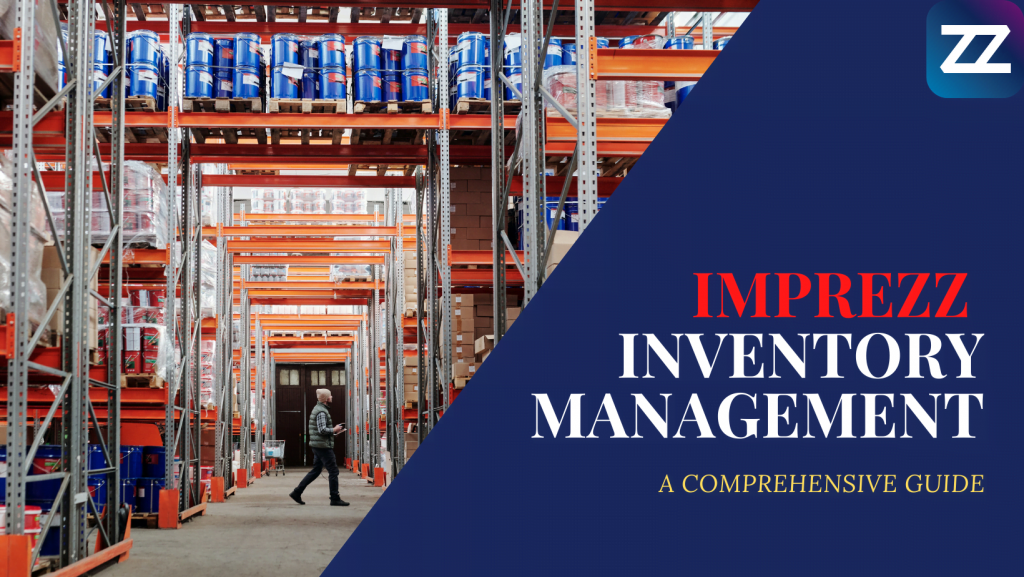
Inventory management is the heart of a growing industry. With its complexity, it becomes tough for those who are starting. This comprehensive guide to inventory management will cover each and every aspect of it, the best techniques you need to follow, the best practices, the ideal software, and much more. It also covers how Imprezz can help you follow all the following techniques to scale up your business. So sit tight, and learn from the most comprehensive and detailed blog on Inventory Management.
WHAT IS INVENTORY MANAGEMENT?
Inventory management refers to the planned and systematic method of ordering, storing, and selling a company’s inventory. This includes the management of raw materials as well as finished goods, not to mention proper warehouse management, to avoid inventory from becoming dead stock. To get familiar with these terms, read: Inventory Management: Basic Terms And Their Application
For companies having complex supply chains and manufacturing processes, inventory management becomes quite daunting. This calls for the use of advanced software like that of Imprezz, which help automate several repetitive manual tasks, saving time and effort to focus on the more critical aspects of growing the business.
WHAT IS INVENTORY CONTROL?
Inventory control revolves around the idea “How much stock should I order?”. It is the process of keeping the right amount of inventory or stocks to avoid shortages, overstock, manage potential deadstock, and other problems leading to drastic losses.
Inventory control focuses on cutting down slow-selling items and increasing the more popular ones. Its sole purpose is maximising profit with the minimum investment in inventory. In short, inventory control is based on Warehouse management. This includes:
- Barcode Scanner/ augmented reality: Enterprise-grade barcode scanning text recognition (OCR) and augmented reality (AR) are used and easily deployed to manage Inventory Control or improvise Warehouse Management. All processing happens on the device, thereby increasing speed along with data security.
- Reorder Point reports: The reorder point is a planning method based on previous orders where no bill of material exists. This method is helpful to manage independent demand items.
- Consolidation of sources: Inventory control is helpful to track the location of suppliers, manage and analyse their history and consolidate sources to avoid discrepancies. This is included in inventory management, too, and the same function can be performed by advanced inventory management software.
- Comprehensive Inventory Counting: Inventory counting plays a vital role in identifying minute details in specific parts of the supply chain. This is achieved through various rounds of Inventory counting, and a detailed record is kept, automated using advanced software like Imprezz. A serious and responsible manager is appointed to supervise the counting since lethargy in this step incurs heavy loss for the firm.
- Syncing sales order with a purchase order: This can be achieved only through a centralised communication system, where each entry is synced with all the levels of the business. Imprezz inventory management software is an excellent choice over simple spreadsheets, as it provides a precise mapping of the supply chain with a comprehensive overview of each purchase order, allowing smooth integration with the sales order.
WHAT IS THE DIFFERENCE BETWEEN INVENTORY MANAGEMENT AND INVENTORY CONTROL?
While inventory management has a much broader scope, inventory control is the subset of inventory management. Inventory management is the management of the entire supply chain all the way from raw materials to the finished goods. On the other hand, Inventory Control is based on Warehouse Management, the amount of stock available, optimising the stock quantity for increased yield, etc.
Which comes first? Inventory Management or Inventory Control?
Thankfully, unlike the chicken-egg dilemma, there is a clear answer to this. Inventory Control comes first, followed by Inventory Management.
Since Inventory Control deals solely with raw materials, there is no doubt it must be optimised first to smoothen the subsequent processes. The stocks present in the warehouse must be carefully analysed based on demand, segregated, and then proceeded further in the supply chain. We shall discuss more about inventory management techniques later.
After the optimisation of the inventory in the warehouse, the use of advanced software facilitates clarity and provides a birds-eye view of the entire functioning of the supply chain. The systematic mapping and making a detailed chart of each step of the supply chain ensures none of the common mistakes of inventory management, such as inventory getting lost, never takes place. Hence the correct order optimises the raw material through inventory control, maintaining clarity through inventory levels, and selling the product using efficient inventory management techniques.
WHAT MAKES INVENTORY MANAGEMENT AN INDISPENSABLE PART OF A BUSINESS?
The following points emphasise the importance of Inventory Management:
- Winning the heart of customers through exemplary service and satisfaction is what really matters in growing a business. This can be achieved through a smooth supply chain, where each inventory is accounted for.
- In a business with a complex supply chain, inventory can easily be misplaced or left unaccounted for. This causes disruption in the entire supply chain since it is a continuous process. Hence proper strategy with clear visibility on each and every inventory is required.
- The inventory bought use up most of a firm’s working capital, and any tiny error causes a drastic loss to the total cost of a firm. To curb this issue, special care must be taken to keep track of each and every item through exemplary Warehouse Management and analytics tools so that they don’t turn up to be dead or ageing stocks.
These three points sum up the extreme importance of inventory management in a business. To improve customer satisfaction, have a systematic and smooth supply chain, and curb drastic loss due to common mistakes of over or understocking, use advanced software like that of Imprezz, which automates these tasks, and you need not worry about losing track of any of the inventory. To get a detailed analysis, read: Inventory Management 101: Small Business Guide
WHAT ARE THE INVENTORY MANAGEMENT TECHNIQUES?
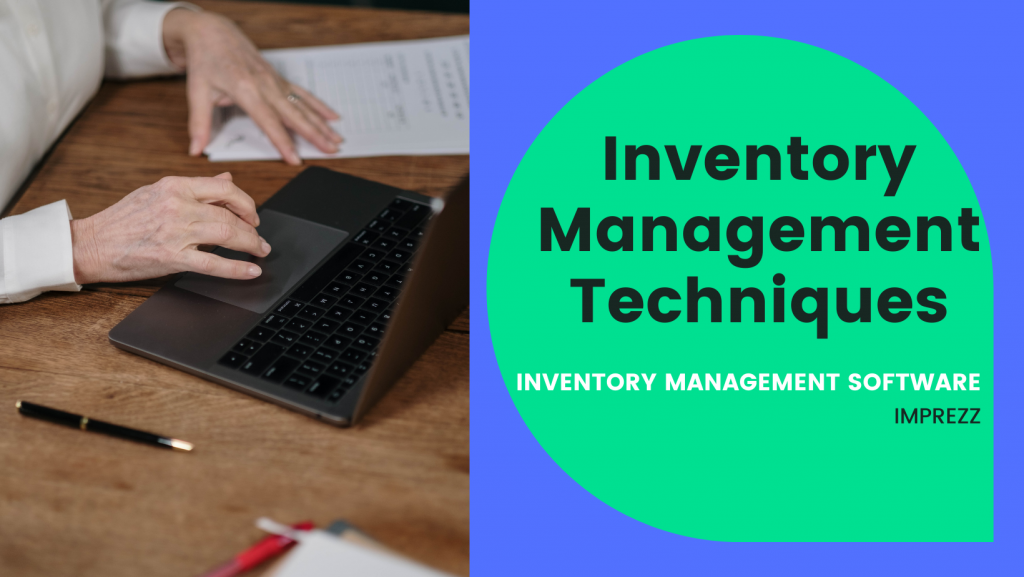
There are predefined techniques in Inventory Management System curated by experts to optimise Inventory Management to its core. Let us discuss all these techniques one-by-one comprehensively, yet the choice of technique is left upto you. Every approach fulfils a specific requirement, and some contradict one another, and you have to select the one that best suits your needs.
- Economic Order Quantity (EOQ): Economic order quantity or EOQ is the technique based on buying the ideal quantity of inventory required analysing various factors such as total costs of production, demand-supply ratio, customer interests, and others. Its primary objective is to solely minimise the investment by freeing the tied-up cash for most firms.
- Minimum Order Quantity: This is the minimum amount of stock that a supplier is actually willing to sell. The retailers are bound to order/purchase this least amount of stock in order for the supplier to sell it to you.
- ABC Analysis: This technique makes use of setting priority for type of inventory having maximum profits, hence are categorised as A. The ones yielding the least profit are labelled C. This method is useful to prevent a stock from becoming an ageing stock or a dying stock.
- Just-In-Time Inventory Management: This method analyses the stock needed and get it as they need. The stock is not stored but purchased as and when needed, reducing the cost of storage or maintaining a proper functioning warehouse facility. This is extremely useful because then the advanced software totally used up for Warehouse Management can now be utilised for other analytical tools to maintain the proper functioning of the supply chain.
- Safety Stock Inventory: This method makes use of ordering extra stock, much more than the predicted demand. This prevents inventory from becoming understocked due to incorrect and faulty forecasting.
- FIFO and LIFO: First In First Out is the method of selling the oldest inventory first, hence preventing stock from becoming deadstock. Last In First Out is the method of selling the newest item first, hence preventing stock from becoming ageing stock.
- Reorder Point Technique: This technique makes use of a firm’s own cycle to predict the amount of stock to be purchased and is an extended version of the Safety Stock formula. This helps significantly lower lead time.
- Perpetual Inventory Management: This includes physically and manually counting the inventory as and when it arrives and can be performed without the use of heavy advanced software. The simple use of spreadsheets along with pen and paper is enough for this method, though no guarantee of this method’s effectiveness in large businesses.
- Dropshipping: This Inventory management technique involves not having any physical interaction with the stock but instead acts as a medium between the buying and selling between the customer and a third party. This is done by not physically storing the goods in the firm’s own warehouse but instead making the third party directly delivering the finished goods to the customer directly. This significantly saves the company lots of money not spending on advanced software for Warehouse Management.
- Demand Forecasting: This has become a very common inventory management technique nowadays among retailers. It uses analytics tools like Imprezz to calculate and predict the future customer demands and order supply according to that. It totally relies on forecasting and can be clubbed with safety stock inventory management technique to increase effectiveness.
Read the blog to know these techniques in detail: INVENTORY MANAGEMENT: BEST PRACTICES AND PROCESS
WHAT ARE SOME NEW TECHNIQUES DEVISED FOR THE SUDDEN PANDEMIC?
The sudden pandemic of Covid-19 has disrupted most businesses that were not digital and had a physical presence in the marketplace. The time has come to devise and follow certain special techniques to cope up with the changing market and gain an edge over our competitors.
- Pay Attention To Customer Demands: The pandemic has led to the growth of e-commerce and has led to significantly high returns in the market. The specificity of orders has drastically increased, and customers know exactly what they wish to order. This type of fluctuating demands of customers can only be managed through closely monitoring customer demands and stocking supplies according to the point of sale.
- Focus On Data-Driven Processes: The fluctuating demands of customers have led to higher returns of stock that have been purchased, which get stored in the warehouse and subsequently develop into dead or ageing stocks. This can be prevented by following a data-driven approach. Analysing each and every inventory returned can help in ordering EOQ or following other efficient techniques like JIT for exemplary Warehouse Management.
- Consolidating Suppliers: If you observe carefully, the firms which have been worst hit are the ones who were completely dependent on Chinese Manufacturers, and after the ban, they suffered a drastic loss of working capital, hence jeopardising their business. To avoid this sort of scenario, advanced business analytics tools like that of Imprezz must be used to check the reliability of suppliers, their history and to diversify our reach. This helps curb the reliability of the entire business on a particular supplier.
- Plan Ahead: The most underrated technique, businesses that had a backup plan are the ones who are leading the market now. Planning ahead for unforeseen circumstances is the most crucial aspect of a business. This helps us have peace of mind, combined with a backup plan for such circumstances. This involves storing our database as cloud data, implementing advanced software of AI and IIOT for inventory tracking, and digitalising our business to never get affected due to calamities.
A COMPLETE ROADMAP TO IMPREZZ INVENTORY MANAGEMENT
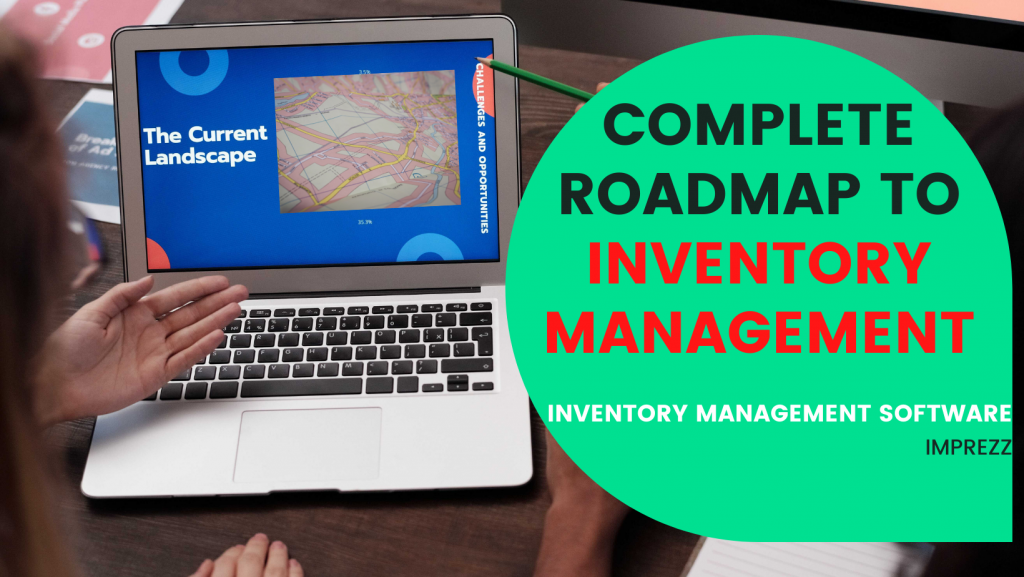
Step-1: Review the current Inventory Management Processes
Schedule and plan a designated time to review the materials available, evaluating the product numbers, descriptions, quality, etc. Also, assess the type of software being used and if it’s up to date.
Step-2: Strategize and Organize
In order to streamline the supply chain, organising the crib or warehouse plays utmost importance. Imprezz inventory management software follows certain steps. They include:
- Categorising and grouping inventory based on priority
- Establishing optimum levels for each product
- Devising perfect planning using charts and analytical tools to check inventory cost
- Cleaning, furnishing and making the warehouse more organised
- Removing the dead and ageing stocks
- Establishing a centralised communication system
Step-3: System Setup
After the organisation and planning, and all the needs assessed Imprezz product sales representative would facilitate the complete setup of the Imprezz Inventory Management Dashboard. This step will include:
- Loading the product with the correct descriptions and credentials
- Creating specifics about each product’s storage in the warehouse
- Setting up and verifying the purchase orders
- Placing the initial stocking descriptions and assisting in the management
- Delivering products to the different stocking levels at the crib/warehouse digital platform
Step-4: Execute and Launch
With all the steps complete, the Imprezz experts will help you go live, consolidate suppliers, and execute all the inventory management techniques discussed above. The final step includes:
- Setting up and going live with vendors
- Ordering or purchasing the inventory through Imprezz analytics
- Following the JIT and EOQ methods to execute inventory optimisation
- Setting up real-time tracking for the most effective Warehouse Management.
AN EXPERT SUMMARY
Amid the sudden pandemic of Covid-19, businesses that could adapt to the digitalisation of companies and use advanced software in an informed and intelligent manner are the ones who flourished. Digitalisation has led to an even playing field. The difference in gaining an edge over the competitors lies in how well a business uses the different technologies. Read: What is the best free inventory management software?
Imprezz Inventory Management is the best tool to manage inventory because of the vast and extensive features it offers and the fact that the simple and user-friendly interface is straightforward for businesses to get used to. Sign up now to try out Imprezz with its 14 days free trial. Let the experts help you grow your business and scale up to new heights.
OTHER BLOGS BY IMPREZZ
- How to Leverage Accounting Automation? – Small Business Guide
- Basics: Accounts and Records Under GST
- Funding Guide to Your Small Business Idea

The government has extended the timelines for Income Tax and GST compliance amid the covid-19 crisis to ease the burden of coping with the tight deadlines during its second wave. As mentioned in the previous news article, the finance ministry had been receiving numerous requests from all industries to ease the deadlines and extend them, and their call has successfully been heard.
With this exponential growth in the Covid cases, experts from all the industries feel that the timelines will have to be extended even further. “In view of the severe impact of the Covid crisis, and also in view of the numerous requests received from taxpayers, tax consultants and other stakeholders from all over the country, requesting the deadlines to be relaxed, the government has decided to extend certain timelines today,” the Central Board of Direct Taxes (CBDT) said.
Those filing GSTR-3B with a turnover of up to 1 CR. have 30 more days, after which they will need to pay the penalty of late fee. Those with a turnover up to 5 CR have 15 more days than the others. The due date for GSTR-1 and sales return has been extended to May 26.
For businesses with a turnover of over 5 CR would have to pay an interest of 9 per cent for a delay of 15 days, while ones with turnover up to 5 CR would not have to pay any interest for the first 15 days, after which it is 9 per cent for them too, which is half of the previous value.
READ THESE BLOGS TO KNOW MORE ABOUT GST:
- Transfer of Business and GST Implications
- GST Rules for Start-ups in India
- Which GST Compliant Software to Use for Invoicing?
- Basics: Time, Place and Value of Supply Under GST
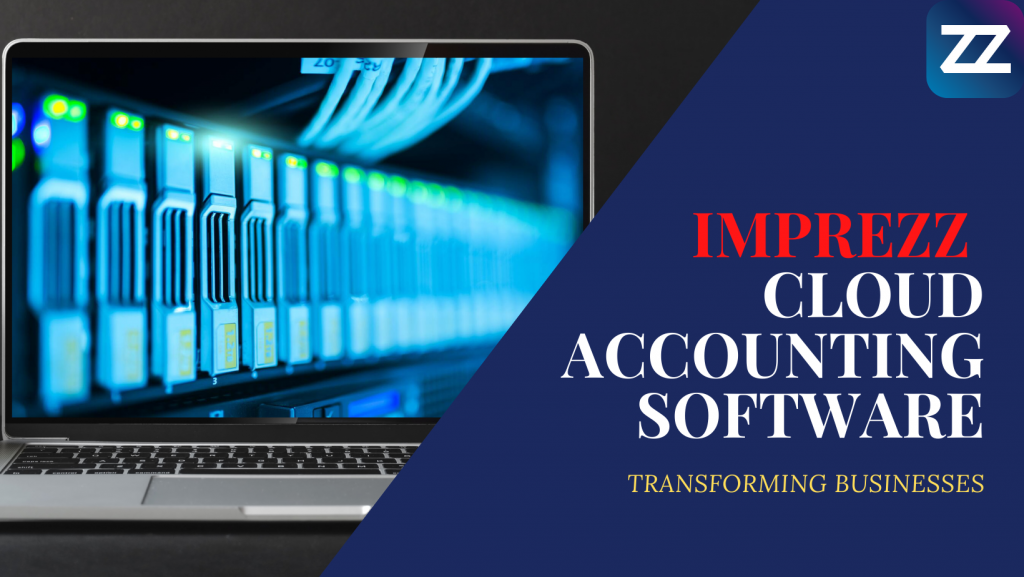
Cloud accounting software or online accounting software is an accounting server hosted on a remote network. It is both safe and convenient. You can access your financial data anytime from anywhere. You get an up-to-date view of your financial data when it is hosted on the cloud.
What’s more, with Imprezz cloud accounting software, you don’t have to worry about wasting time to install and update like the regular software. Simply access it from your mobile, laptop, or browser. Imprezz supports all the requirements for your accounting. The operation of the software is easy: you don’t have to be a trained accountant to use it.
With the Imprezz online accounting software you can :
- Access financial data 24 *7 from anywhere,
- Collaborate with your colleagues,
- Safeguard your data through automatic backups,
- Track all the income and expenses,
- Send professional invoices, offers, delivery notes, and reminders.
You can collaborate with the bookkeeper or accountant provided if you have time for it. And if you have the necessary financial know-how. This is probably not the case with small businesses and freelancers.
More information about the benefit of this accounting software for small businesses can be found in the article “How Imprezz Accounting Software benefit My Small Business“?
What is Cloud Accounting Software?
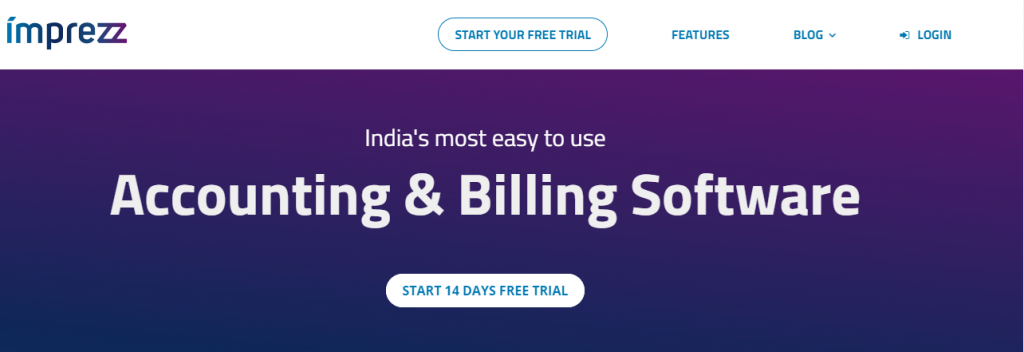
Accounting software that is hosted on a remote server is called cloud accounting software. The users save the data on the cloud where it is processed and sent back to them.
You can access it via the internet or any other network on a cloud application software. Everyone in the company can have access to the software on their own devices. Thus, companies no longer have to install individual desktops with software installed on them. The same data on the cloud can be accessed by your remote team or colleagues using the same version of the software.
Cloud accounting software: Features
Below listed are some great features offered by Imprezz online accounting software.
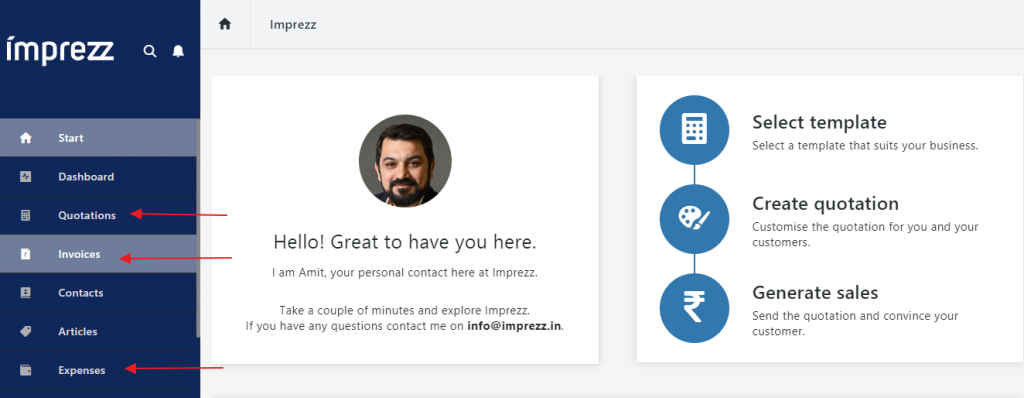
1. Manage your business easily
The software helps you access data, manage the business, and stay updated on your computer, laptop, or mobile phone. The detailed charts and business analytics tool provide the best combination for financial management and scaling.
2. Track your expenses
You can track all your expenses for taxation purposes even using the mobile app. You can simply record or download the receipts from the Imprezz cloud accounting software. This will help businesses maintain a clear record of the finances because playing with the working capital is similar to playing with fire. One wrong step and heavy losses are incurred, leading to a significant loss in the working capital.
Do read: Automate your payment reminders with Imprezz to get a clear idea of the payment automation and how to optimize tracking of expenses.
3. Create and Send Invoices
Create and send professional invoices, purchase orders, custom and sale receipts and estimates that you can send in minutes. Imprezz software has features to automate business accounting to help prevent performing mechanical repetitive tasks, and also spend the time productively. Automating prevents errors like double-entry or data entry errors, which lead to significant losses if not identified.
4. Position of your business
The tool helps you track the current position of your business with the help of dashboards and customizable reports. The real-time tracking facility is one of a kind, and try it out yourself to get a taste of scaling up your business using Imprezz Cloud Accounting Software. This will create your position of superiority over your competitors, through the correct use of advanced software like Cloud Computing, which has become a necessity in this digital era, where every business is hosted online.
5. Control your cash flow
Enter bills from vendors, and pay them only when they are due. Schedule payments don’t only save time but help you keep control of your cash flow. Imprezz Cloud Accounting software helps track account payable or accounts receivable with ease, and hence easing the unnecessary burden of maintaining records mechanically.
6. Tech Support
The best feature of cloud-based accounting software is access to tech support. You can access tech support via telephone or chat and get instant help from technical professionals available who will walk you through any issues you might have with the cloud-based software. Experts are present 24/7 to provide chat as well as call assistance in case any problem is faced in any of the features. This is extremely crucial because the guidance of such experts can optimize your dashboard, helping you make your decisions with more ease.
How does online accounting software work?
Using cloud accounting software help you manage your books anytime across multiple devices.
- You can access and manage your financial data from your computer, laptop, tablet, or smartphone anytime you choose.
- Give access to your colleague or accountant can log in and work with your data online.
- Estimate your cash flow and current income and expenses – your data is synced and backed up automatically.
- After every revision, you don’t need to worry about saving because it is automatically synced to the cloud database.
Archive and backup your data
What’s more, Imprezz not only protects you against the frequent changes but helps in maintaining books properly for compliance in a later audit.
Are you stressed about losing data? Tough manual backups. It’s the time to change :
- Imprezz helps you access your financial data 24 hours a day, 365 days a year.
- Prevent unauthorized access to your data with strong passwords and an authentication process.
- The cloud accounting software helps you manage everything in one place. Record your transactions, send invoices, automate payments, etc.
Above all, automatic backups ensure that your data is archived securely and in accordance with the law in the long term. This prevents any kind of security leak, and helps store your data securely, making it accessible with just a click of a button!
Cloud Accounting Software: Is my financial data safe?
Cloud accounting software provides you with a more secure method of storing your financial data than traditional accounting software. Storing critical data on your company laptop or computer could be lost or stolen, resulting in a data breach. However, with online accounting software, your data is stored on the cloud, and access to data is encrypted and password protected.
Sharing data with cloud accounting is easy and secure. To access the company data you need access rights to the system with a unique password. Traditional accounting methods need a flash drive to share data, making it vulnerable for data to get lost or stolen.
Lastly, the data stored on cloud accounting software can be retrieved in case of any damage or natural disaster. Cloud providers have back servers which means you can still access the data if one or more server is down.
Cloud Accounting Software: Save Money
The objective of adopting any new technology is to save money and time. Is it the case with online accounting software? Let’s look at different ways how it will help you save a few bucks and make it easy :
- Less cost involved in building a secure infrastructure to store data.
- No, IT staff is required to maintain or update cloud accounting software.
- Few overhead expenses and no requirement to purchase individual software, which means more savings for the business.
- Companies no longer have to invest in skilled staff and their training.
- Save money on office supplies every month.
- Cut back on costs with increased productivity and efficient working.
Bottom Line
The old adage- Time is money is more relevant today than ever before. Cloud accounting software provides real-time information to business owners and helps them make informed decisions. Access to real-time financial information keep them informed as to the financial position of the company and take all the necessary decisions. Small business owners can leverage accounting automation to track their cash flow with the income and expenses statement. If the business owners find that the amount is being spent on a particular task with little or no ROI, they can immediately cut down the unnecessary spending. In recent times, cloud platform has gained traction, and those businesses who use them in an informed and optimized manner are the ones who can gain an edge over their competitors.
Any questions?
If you are looking for more tips on online accounting read a few Imprezz blogs :
Basic Fundamentals of Accounting
Future of Accounting Software in India – Trends and Forecast
Basics: Accounts and Records Under GST

The industry has requested the government for more handholding to clear tax-related confusions and GST filing. Tax compliance deadline extension has also been requested.
WHAT ARE THE REQUESTS?
The finance ministry has been approached by the industries to provide clarity, speed up the processes, and also provide more handholding on the numerous tax issues. With the sudden economic changes and all the uncertainty, the major industry bodies have approached the ministry to ease tax issues and requesting more handholding. They have also requested an extension of the deadline in filing income tax and other GST filings under the Income Tax act.
“Unresolved Issues with the Input Tax credit, QRMP, GST returns prevail, and it is important that the government facilitates industries in doing business. The importance of addressing these issues with the ministry in the interest of Trade and Industry cannot be overstated” said Sanjay Agarwal, President, PHD Chamber, stated. (Source: moneycontrol)
WHY IS IT SO IMPORTANT?
Incorrect records may lead to erroneous taxation, causing major discrepancies amongst companies. These codes, though in use earlier, the compulsion to adhere to them during the tax inflation has led to the growth of this confusion. No clarity from the government on which code applies for which product/service may lead to disputes and penalty.
TO LEARN MORE ABOUT GST AND TAXATION
- What is small business accounting – How to do it?
- Basics: Accounts and Records Under GST
- GST Rules for Start-ups in India
- Transfer of Business and GST Implications
- Basics: Input Tax Credit – Comprehensive Guide

Those who aren’t tech-savvy are generally confused by the heavy Inventory Management terminologies used. Today we are going to decouple all the essential terms and understand their applications in Inventory Management. If new to Inventory Management, don’t forget to read: Inventory Management 101: Small Business Guide.
MAJOR CONSTRAINTS IN INVENTORY MANAGEMENT
- Inventory: Defined as the complete list of items bought with the company’s working capital such as property, goods in stock, or the contents in a building.
- Operational Expenses: The firm’s expenditure in the sale of the inventory in stock. In simple words, the total cost in selling the merchandise purchased and stored by the firm.
- Throughput: The output from the sales made, which compensate and generate capital, and lead time for the working capital expenditure in the whole supply chain process.
These trios are the heart of Inventory Management. They are essential to profit and generate more working capital to initiate better management and compensate for effective Inventory Management. Sustaining a firm’s growth is possible only if at least two of these constraints are managed in an informed and correct manner.
INVENTORY TERMS
1. Inventory Control: This involves accounting and the act of physically counting the stock ledger and ensuring they match with the actual data values. The counting of inventory assets and site control fall under this category.
- Stock Take Policies: It involves the processing and recording the amount of inventory held by the firm. This policy applies to Inventory Managers responsible for managing the stocks. They do not take down the data in the databases manually, but automation software like Imprezz play a crucial role in reducing effort and time, hence increasing productivity. The necessity of such software is seen in accounting because of the reduction in mistakes and the short duration of undertaking such mechanical tasks, which take hours for a human.
- Kanban: It is an Inventory Management Technique involving Just-In-Time and lean manufacturing processes. It is, in short, a scheduling system for organising the supply chain. This process is used by managers to track the progress of the inventory, hence provided a clear view of the entire supply chain.
- Perpetual Inventory System (ERP): Enterprise Resource Planning refers to the various software and technologies used to plan and manage the supply chain and manufacturing effectively. It is a real-time process mediated by advanced software like that of Imprezz.
- Dead Stock Management: Inventory with no turnover, which has undergone no sales, is termed dead stock. Forgotten and neglected dead stock in the warehouse is the direct result of poor warehouse management. Deadstock management must be implemented with proper technologies to reduce the excess useless stock.
2. Inventory Planning: With the suddenness of the pandemic, the firms which had the perfect planning for unforeseen events are the ones who have gained an edge. Planning according to the future demand forecast and stocking accordingly falls under Inventory Planning.
- ABC Classification: Classifying the inventory based on priority is one of the most effective Inventory Management Techniques. This includes giving more priority to the stocks yielding more profit and giving the least priority to the one forecasted to be deadstock. This reduces the overstocking of the unwanted stocks and rich storage of the most profitable inventory in the warehouse.
- Age Reserve Planning: Inventory Reserve is a contra asset of a firm’s balance sheet and ledger files, made in anticipation of forecasting inventory potential to be deadstock. This extra list of Inventory Reserve Planning will greatly help the firm curb the loss in working capital due to overstocking.
- Supply-Demand Planning: Self-explanatory name involves carefully analyzing all the trends in supply-demand ratio using automation software and managing inventory accordingly. Analyzing Inventory levels is a must for this step. This is almost similar to Economic Order Quantity (EOQ)
3. Inventory Management Processes: This is the complete integrated management system of the supply chain, keeping in mind the above two processes. It incorporates advanced software of Inventory Management, automation technologies, and other software like IIOT and AI.
- Strategic Stocking Levels: Stocking strategy enables moving inventory to the active inventory category, ensuring the firm stocks the right inventory and optimises the process. This means there are no discrepancies of over or understocking due to the lack of transparency or a good centralized communication between the levels of the business.
- Integrated Business Planning: This is a process of maximizing profit/cash flow while minimizing risk using financial and operational optimization technologies. This uses strategy and mapping technologies like that of Imprezz, which provides a detailed strategy chart of each inventory and the specifications of the article in the same place. In other words, each inventory is tracked real-time using the software for creating the scope of reorder point.
- Inventory Optimization: Taking the supply and demand volatility into account, the most effective balancing of capital investment and service-level goals over large quantities of stock is called Inventory Optimization. This smoothens the functioning of the supply chain, and Inventory Optimization helps increase the percentage yield with the expenditure of the same working capital.
- Strategic Sourcing: The approach by a business to consolidate the purchasing power to find the best possible sales deal and the best return for the inventory. This takes place at the final part of the supply chain, i.e. the sales and marketing department. It is given so much importance because the return on investment made so much on the inventory and management software are decided based on strategic sourcing.
- Sales and Operations Planning: This process involves all the levels of a business working together through a centralised system. The smooth functioning of the supply chain is solely dependent on this step, and good software like that of Imprezz provides a well-integrated communication system for the same. Firms must focus on creating a single production plan and adhere to it carefully, right from sales order/purchase order.
- Inventory Carrying Cost Strategy: Inventory carrying cost is the gross net amount spent on storing the inventory. It includes intangibles like depreciation and lost opportunity cost and the cost of storing finished goods in the warehouse. This strategy revolves around warehouse management and dead stock management.
INVENTORY MANAGEMENT INDICATORS
Managing inventory is not a single step process. There are several indications that provide an idea about the efficiency of Inventory management in a firm. Reducing such indicators, which are liability, is the key to implement a great Inventory Management Strategy. These unproductive burdens are mentioned below, and companies must take extra care to remove them from the supply chain.
- Spoilage: Spoilage are goods harmful goods which cannot be moved further lest it harms the consumer. Reducing spoilage must be made an integral part of an efficient supply chain.
- Dead Stock: Products that are no longer in demand and are waiting for an ambitious customer to buy them. This deadstock must be reduced, lest huge losses due to overstocking can be incurred by the firm. Good Warehouse Management Software like that of Imprezz are the correct choice. People generally confuse it with safety stock, but safety stock is an asset rather than a liability.
- Ageing Stock: Stocks whose current price is no longer appealing to the customer are called ageing stocks. Providing lucrative deals help manage the ageing stocks, leading the customer to buy these stocks in bulk. Ageing stocks are like a time bomb. The more the delay, the cheaper it must be sold. What must be taken care of is none of the stock becomes ageing stock, and the solution is simple. Use Business analytics tools like Imprezz, which keep track of each article in detail.
- Unproductive Cash Usage: Creative ways must be devised, which ensures the burden of carrying extra inventory is lifted from your shoulders. It can be achieved in several ways:
- Dropshipping: A passive method where the third party, i.e. the vendor, ships the inventory directly on your behalf, hence reducing storage costs of raw materials.
- Consigned Inventory: The third party, i.e. the suppliers, retain the inventory ownership till the consumption of the supplies by the customer. This reduces the chances of stocks getting converted to ageing stocks.
- Cross-Dock: The technique in which the finished product doesn’t even set foot in your warehouse, but there is a direct transfer of goods right from the inbound trailer to the outbound trailer, making the handling cost negligible.
The importance of the Inventory Management system is already illustrated in the blog: Inventory Management 101: Small Business Guide. Yet, this blog instigates another line of thinking: should we focus on Inventory Management or Inventory Minimizing? This debatable topic needs a detailed analysis from your end, what kind of business you are running, the logistical and storage cost accosted with your product, and many other factors.
Use Imprezz Inventory Management Software to get a detailed idea of which works best for you and which you must go with. To facilitate this food for thought, a 14 day trial period has been provided to ponder which works best for your business and the line of action you can take. To learn from experts, try reading: A Complete Guide To Inventory Management.
MORE INFORMATIVE BLOGS
Basics: Accounts and Records Under GST
Small Business Checklist: Steps to Start a Small Business
How to Succeed with a Business at Low Investment in India?
As we have seen in all our previous blogs (Inventory Management 101: Small Business Guide and Inventory Management Techniques: 2021 Edition) that inventory management is a visual analyser used to track inventory in real-time. Certain good practices in Inventory Management processes will help you best utilise cloud computing and analytics software and hence curb losses due to mismanagement.
1. KNOWING THE CORRECT INVENTORY FOR YOUR BUSINESS
Each business has a different inventory set that correctly suits its needs and has the most effective management techniques curated for the same. So it is crucial to identify the type of inventory that suits best your business and how you order it.
We have discussed the various inventory management techniques here, but let’s recap two of them in brief:
- Continuous Evaluation: With a continuous evaluation review system, we optimise our order according to the exact amount needed. This uses the pull/JIT method as described here. This method requires critical evaluation and monitoring, and the moment the stock is on the verge of getting over, it must be replenished. This calls for some advanced monitoring software like Imprezz, which provides clear visibility on each inventory and provides a real-time tracking facility.
- Periodic Evaluation: This follows the inventory management technique of emergency stocking, as discussed here. The stocking is done after a decided period and evaluated at the end of the period. The excess stock determines the quantity for the next quarter or serves as safety stock. There is no clear planning and no necessity to closely monitor each stock, hence not optimising the inventory in the best possible way.
2. IMPLEMENT CENTRAL COUNTING PRINCIPLE
To find discrepancies in the supply chain, this step is the most effective one. Central counting is so effective because it provides a birds-eye-view over the complete functioning of the inventory levels/stock levels, hence easily spot the loopholes and correct them accordingly. What are the factors to keep in mind?
- Frequency: Decide the frequency of counting and increase it to enhance the probability of finding intricate faults, easily missed through rare counting.
- Strategise: Demarcating a clear strategy plays an important role to improve the effectiveness of counting. “Failing to plan is planning to fail.” sales order/purchase order too plays an important role here.
- Authority: Someone with a great sense of work ethics and reliability must be made in charge of counting rounds because even a single mistake could directly impact the firm’s total cost.
3. WAREHOUSE MANAGEMENT
Most businesses neglect this crucial step, but its importance cannot be undermined. The storage of the raw materials go through a series of common problems:
- High Storage cost: Following the Economic Order Quantity (EOQ) or Just-In-Time inventory management techniques are the best methods to solve this problem. Have trouble following? Check out: Inventory Management Techniques: 2021 Edition to familiarise yourself with all the various techniques and terminologies. The amount of inventory must be carefully tracked using charts and other strategy tools.
- The possibility of becoming Ageing stock: This is a critical situation when the final product prices are not lucrative enough for the customer to buy them, making them a potential deadstock. To curb this issue, a systematic chart must be made using software like Imprezz to keep a check on the latest price, the rate of inflation, and whether a stock is turning into an ageing stock. Sell them at lower prices to prevent them from becoming deadstock.
- Stocks turning into deadstock: This is the worst possible case where there is no sale of the inventory, and not many people are interested in the particular stock. A proper warehouse management system like Imprezz is absolutely critical because this problem leads to a drastic loss in working capital. The above-discussed Inventory Management techniques such as JIT and EOQ are practical too.
4. QUALITY AND INVENTORY CONTROL
In any business, customer satisfaction is of the utmost importance. What’s more important is to impress the customer through the exemplary quality of the finished products and match the exact descriptions mentioned in the product description.
Making a checklist mentioning all the intricate details of the things to be kept in mind is the best possible way of quality control for finished goods. Some pointers can be:
- Damage or flaws: Check for dents, deformities, or damaged spare parts.
- Product Details: Includes colour, pattern, shape and looks.
- Cost and warranty agreements: These must be strictly adhered to, and the details must specifically be mentioned beside each product.
These are not just the only parameters that matter. Storing the raw materials in warehouses have their own set of problems. These include fluctuating temperature, light and humidity.
5. OPTIMIZATION OF INVENTORY MANAGEMENT SYSTEM
Inventory management is the heart of a business and relies on the rich supply of product and the best possible management of these inventories. So why is inventory management optimisation important?
- Fluctuating Customer Demands: During the current pandemic situation, customers have become more selective in buying products, and their demands have become more abrupt than ever before. The rise of e-commerce has been a significant stimulus in this change, and hence we must be careful in managing inventory to curb the direct impact on our working capital.
- Increasing Competition: Each business has its own set of competitors, and the pandemic has led to an even set field due to the compulsion in digitalising all the system. Reorder point getting affected is a major concern. What matters now is how well a business manages its inventory through an informed and correct way using advanced software like Imprezz. Want to take informed decision taking help from experts? Read: Tutorial: How to use Imprezz inventory management tool?
- Reduced Working Capital: The Covid-19 pandemic hit every business adversely, and the working capital of every firm has diminished drastically. Spending most of it on inventory makes inventory management the heart of growing the business without incurring losses. Having to deal with loss in the current situation and restricted cash flow is the worst possible nightmare for any business, and the only way to evade it is Inventory Management optimisation.
6. AUTOMATE EVERYTHING POSSIBLE
Complex tasks can easily be automated using Automation technologies like Imprezz. This ensures enhanced efficiency with less human dependency, leading to less time wasted in managing mechanical, repetitive tasks, where that workforce and time can be utilised in other productive tasks. To know more about automation, check out: How to Leverage Accounting Automation? – Small Business Guide. The achievable aspects are:
- Customizing the storefront for B2B buyers.
- Consolidate sellers, and reduce dependency.
- Managing data entry into accounting software.
- Track and plan how to increase revenue
- Bulk-order management and warehouse automation.
7. FOLLOW ADVANCED INVENTORY MANAGEMENT TECHNIQUES
Advanced Inventory management techniques include ABC categorizing, following FIFO and LIFO methods of inventory management. If you want to learn the basics, do check out: Inventory Management Techniques: 2021 Edition.
- ABC Categorizing: This involves planning and giving priority according to the profits yielded by the particular inventory, keeping the topmost priority one as A and the least priority one as C. This helps in reducing wastage of the high demand and the most costly inventories, hence yielding more profit for the firm.
- FIFO: First-In-First-Out is the technique of selling the one reaching first, hence reducing the chances of inventory turning into ageing stock.
- LIFO: Last-In-First-Out is the technique opposite to that of FIFO where the last item is sold first, hence none of the items turn into deadstock, generating lead time.

HOW CAN IMPREZZ HELP ME IN INVENTORY MANAGEMENT?
Software made by the experts, it is adept in solving all these common problems strategically and in a systematic manner. Each of the best practices mentioned above is followed by Imprezz and curated by experts in Inventory management, the simple user interface makes Inventory tracking a cakewalk.
Imprezz Inventory management software clubbed with Accounting Automation technology can provide the much-needed boost to your business, providing an edge over your competitors. The informed and correct use of the software is the key to have an edge in these trying times of online business. Let us help you, sign up for a free trial of 14 days to feel the rush of scaling up!

